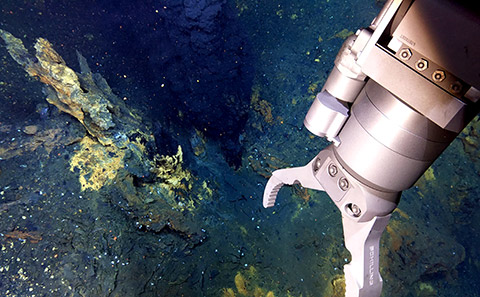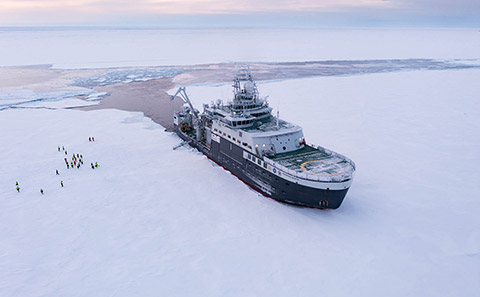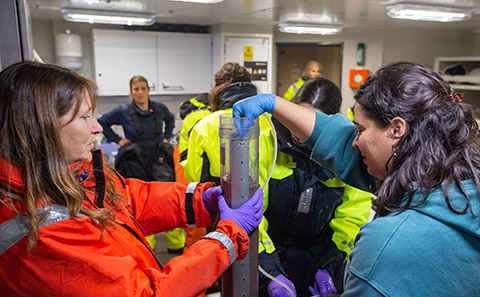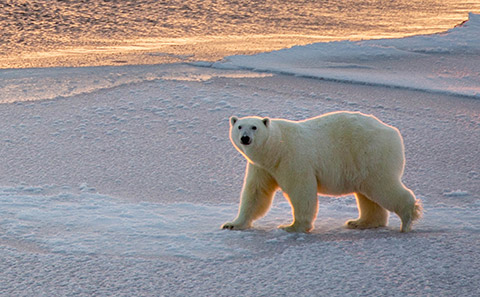An international research team, including Dr Maria Baker from the University of Southampton, has taken a major step forward in deep-sea exploration by sampling and filming one of Earth's last truly remote and inaccessible environments: hydrothermal vents lying four kilometres beneath the Arctic ice.

At 82.5N latitude, this is the first-time hydrothermal vents, also known as underwater volcanoes, have been successfully investigated so far north. The analysis of the samples retrieved - rocks, fluids, sediments and fauna - will allow researchers to understand more about how fauna has been able to survive and evolve in such an inhospitable environment and could provide insight into how early life formed on Earth.
The HACON 2021 expedition took place over a three-week period in September and October 2021, led by CAGE/UiT (The Arctic University of Norway) and the Norwegian Institute for Water Research (NIVA). A team of 28 scientists, engineers and communication experts came together on board the icebreaker RV Kronprins Haakon to explore 'black smoker' hydrothermal vents in one of the most inaccessible vent fields on the planet, the Aurora vent field on the Gakkel Ridge at 4000m depth. The vents are called black smokers because of the dark hot liquid (over 300 degrees Cecius) that has a smoke-like appearance as it is emitted from under water chimneys.

The Aurora vent field was first detected 20 years ago, when hydrothermal rock material was dredged from the seafloor. It remained unexplored until 2014, when the first visual confirmation of the active black smokers was obtained. The HACON team revisited this site in 2019 providing additional high-resolution images of the hydrothermal vent field obtained with a towed camera. The team was unable to directly sample the site with an ROV (Remote Operated Vehicle) due to the technical challenges of working in thick, drifting ice conditions.
This time it was different. For this latest visit, the team deployed a new ROV named "Aurora", provided by REV Ocean. This was the first expedition for the ROV and resulted in the first detailed visual survey and mapping of the Aurora Vent Field and collection of more than 100 visual, geological, geochemical, and biological samples.
The samples taken of high-temperature fluids, chimney rock, sediments and fauna will now be analysed at laboratories in the partner institutes to get a better understanding of the composition and functioning of the vents.

Forty years after the first discovery of deep-sea hydrothermal vents, the HACON21 cruise has added a wealth of visual material and physical samples of the first hydrothermal vents ever studied in the Arctic Ocean under ice. These data help to complete one of the missing pieces of the global biogeographic puzzle of vents around the globe.
Dr Maria Baker, University of Southampton took part in the expedition. She currently works at the interface of science and policy as co-lead for the Deep-Ocean Stewardship Initiative (DOSI) and has also helped to develop a new UN Ocean Decade programme, Challenger 150. HACON 2021 was the 4th expedition associated with this ambitious programme. Dr Baker said, "I was thrilled to be invited to contribute to this 'high risk - high gain' expedition that we had discussed many years previously as part of the Census of Marine Life programme. To feel the excitement of historic discovery, meet many fabulous people and learn so much from deep-sea scientists from disciplines other than my own was just wonderful". Dr Baker will work with colleagues in Norway, Portugal and Southampton on the life-history of some of the fauna sampled from the Aurora vent field.
A key goal going forward is to use the results to work together on challenges and solutions related to Vulnerable Marine Ecosystems and Marine Protected Areas. This will result in new science provided to intergovernmental initiatives such as the UN conference on the conservation and sustainable use of marine biological diversity in areas beyond national jurisdiction, the UN Sustainable Development Goals and the UN Decade for Ocean Science, in particular the Challenger 150 programme.







